Cusabio Human Recombinants
Recombinant Human DNA repair protein complementing XP-C cells (XPC) , partial | CSB-EP026217HU
- SKU:
- CSB-EP026217HU
- Availability:
- 3 - 7 Working Days
Description
Recombinant Human DNA repair protein complementing XP-C cells (XPC) , partial | CSB-EP026217HU | Cusabio
Alternative Name(s): Xeroderma pigmentosum group C-complementing proteinp125
Gene Names: XPC
Research Areas: Epigenetics and Nuclear Signaling
Organism: Homo sapiens (Human)
AA Sequence: SLPAASSSSSSSKRGKKMCSDGEKAEKRSIAGIDQWLEVFCEQEEKWVCVDCVHGVVGQPLTCYKYATKPMTYVVGIDSDGWVRDVTQRYDPVWMTVTRKCRVDAEWWAETLRPYQSPFMDREKKEDLEFQAKHMDQPLPTAIGLYKNHPLYALKRHLLKYEAIYPETAAILGYCRGEAVYSRDCVHTLHSRDTWLKKARVVRLGEVPYKMVKGFSNRARKARLAEPQLREENDLGLFG
Source: E.coli
Tag Info: N-terminal 6xHis-tagged
Expression Region: 496-734aa
Sequence Info: Partial
MW: 31.5 kDa
Purity: Greater than 90% as determined by SDS-PAGE.
Relevance: Involved in global genome nucleotide excision repair (GG-NER) by acting as damage sensing and DNA-binding factor component of the XPC complex. Has only a low DNA repair activity by itself which is stimulated by RAD23B and RAD23A. Has a preference to bind DNA containing a short single-stranded segment but not to damaged oligonucleotides. This feature is proposed to be related to a dynamic sensor function: XPC can rapidly screen duplex DNA for non-hydrogen-bonded bases by forming a transient nucleoprotein intermediate complex which matures into a stable recognition complex through an intrinsic single-stranded DNA-binding activity.The XPC complex is proposed to represent the first factor bound at the sites of DNA damage and together with other core recognition factors, XPA, RPA and the TFIIH complex, is part of the pre-incision (or initial recognition) complex. The XPC complex recognizes a wide spectrum of damaged DNA characterized by distortions of the DNA helix such as single-stranded loops, mismatched bubbles or single-stranded overhangs. The orientation of XPC complex binding appears to be crucial for inducing a productive NER. XPC complex is proposed to recognize and to interact with unpaired bases on the undamaged DNA strand which is followed by recruitment of the TFIIH complex and subsequent scanning for lesions in the opposite strand in a 5'-to-3' direction by the NER machinery. Cyclobutane pyrimidine dimers (CPDs) which are formed upon UV-induced DNA damage esacpe detection by the XPC complex due to a low degree of structural perurbation. Instead they are detected by the UV-DDB complex which in turn recruits and cooperates with the XPC complex in the respective DNA repair. In vitro, the XPC:RAD23B dimer is sufficient to initiate NER; it preferentially binds to cisplatin and UV-damaged double-stranded DNA and also binds to a variety of chically and structurally diverse DNA adducts. XPC:RAD23B contacts DNA both 5' and 3' of a cisplatin lesion with a preference for the 5' side. XPC:RAD23B induces a bend in DNA upon binding. XPC:RAD23B stimulates the activity of DNA glycosylases TDG and SMUG1.
Reference: Protein interaction network of alternatively spliced isoforms from brain links genetic risk factors for autism.Corominas R., Yang X., Lin G.N., Kang S., Shen Y., Ghamsari L., Broly M., Rodriguez M., Tam S., Wanamaker S.A., Fan C., Yi S., Tasan M., Lemmens I., Kuang X., Zhao N., Malhotra D., Michaelson J.J. , Vacic V., Calderwood M.A., Roth F.P., Tavernier J., Horvath S., Salehi-Ashtiani K., Korkin D., Sebat J., Hill D.E., Hao T., Vidal M., Iakoucheva L.M.Nat. Commun. 5:3650-3650(2014)
Storage: The shelf life is related to many factors, storage state, buffer ingredients, storage temperature and the stability of the protein itself. Generally, the shelf life of liquid form is 6 months at -20?/-80?. The shelf life of lyophilized form is 12 months at -20?/-80?.
Notes: Repeated freezing and thawing is not recommended. Store working aliquots at 4? for up to one week.
Function: Involved in global genome nucleotide excision repair (GG-NER) by acting as damage sensing and DNA-binding factor component of the XPC complex. Has only a low DNA repair activity by itself which is stimulated by RAD23B and RAD23A. Has a preference to bind DNA containing a short single-stranded segment but not to damaged oligonucleotides. This feature is proposed to be related to a dynamic sensor function
Involvement in disease: Xeroderma pigmentosum complementation group C (XP-C)
Subcellular Location: Nucleus, Cytoplasm
Protein Families: XPC family
Tissue Specificity:
Paythway: DNArepairpathway
Form: Liquid or Lyophilized powder
Buffer: If the delivery form is liquid, the default storage buffer is Tris/PBS-based buffer, 5%-50% glycerol. If the delivery form is lyophilized powder, the buffer before lyophilization is Tris/PBS-based buffer, 6% Trehalose, pH 8.0.
Reconstitution: We recommend that this vial be briefly centrifuged prior to opening to bring the contents to the bottom. Please reconstitute protein in deionized sterile water to a concentration of 0.1-1.0 mg/mL.We recommend to add 5-50% of glycerol (final concentration) and aliquot for long-term storage at -20?/-80?. Our default final concentration of glycerol is 50%. Customers could use it as reference.
Uniprot ID: Q01831
HGNC Database Link: HGNC
UniGene Database Link: UniGene
KEGG Database Link: KEGG
STRING Database Link: STRING
OMIM Database Link: OMIM









